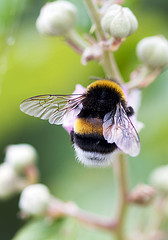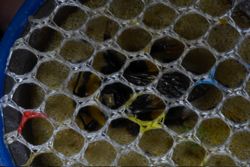
In 1909, 20,000 garment workers in New York City went on strike, demanding a 52-hour workweek, paid overtime, and union recognition. The “uprising,” as described in Susan A. Glenn’s marvelous book Daughters of the Shtetl: Life and Labor in the Immigrant Generation, began a cycle of labor organization that helped build the garment industry unions.
I’ve always had a keen interest in bold women garment workers, especially since my grandmother left school in 1920, at the age of 14, in order to go and work for a court dressmaker in London for a weekly wage of six shillings. (She was sacked after a week for “insolence” after complaining that she had spent all her time picking up pins, not learning a trade.) Imagine my surprise, then, when I learned that it’s not just humans who demand reasonable working hours: bumblebees also adhere to a strict working day, packing up and flying home even during the constant light of the Arctic circle summer.
Ralph Stelzer and Lars Chittka of Queen Mary University of London in the U.K. discovered this with the aid of an extraordinary experiment in which they glued one-millimeter-wide radio frequency identification (RFID) tags on 1049 female worker bumblebees at a research station in Northern Finland and let them fly around foraging freely for nectar during the Scandinavian midsummer. Even though the bees were exposed to 24 hours of daylight, they kept to a strict schedule, foraging only between the hours of 8.00 a.m. and 11 p.m (with most activity around midday). Between the hours of 1.00 a.m. and 6.00 a.m., they rested in their underground nests.
(By the way, if you are curious–as I was–as to how to stick a tiny RFID tag onto the thorax of a struggling bumblebee, here’s a brief explanation from Ralph Stelzer:

“We started the experiments with young colonies containing about 50 to 80 workers and a queen each. Then each day during the course of the experiments all newly hatched bees were tagged right away. For tagging the bees we used standard bee marking cages, a transparent plastic tube with a mesh on one side. The bees are transferred into these tubes with forceps and then gently pressed against the mesh with a cushioned plunger. That way the bees are fixated and the tags can be glued onto their thorax,” through the mesh. See image above.)
Stelzer and Chittka studied both native bumblebees and non-native Bombus terrestris, or European buff-tailed bumblebee, which they imported to the Arctic. One would expect, say the researchers, that the bees would use the 24-hour day to gather as much food as possible and thus maximize colony growth. Instead, like Cinderella, they flew home by midnight, suggesting that the furry workers have some way of telling the time in the absence of darkness – perhaps because they are sensitive to light intensity or changes in temperature.
Taking time off has advantages, says Seltzer. “Despite the light, temperatures do fall during the Arctic ‘night,’ so it may be that the bees need to return to their nests in order to warm their brood. Also, it has been suggested that a period of sleep helps bees to remember information gained during the day’s foraging.” Time for a nap!
Image 1 courtesy of Laurent Jégou
Image 2 courtesy of Josef Timar